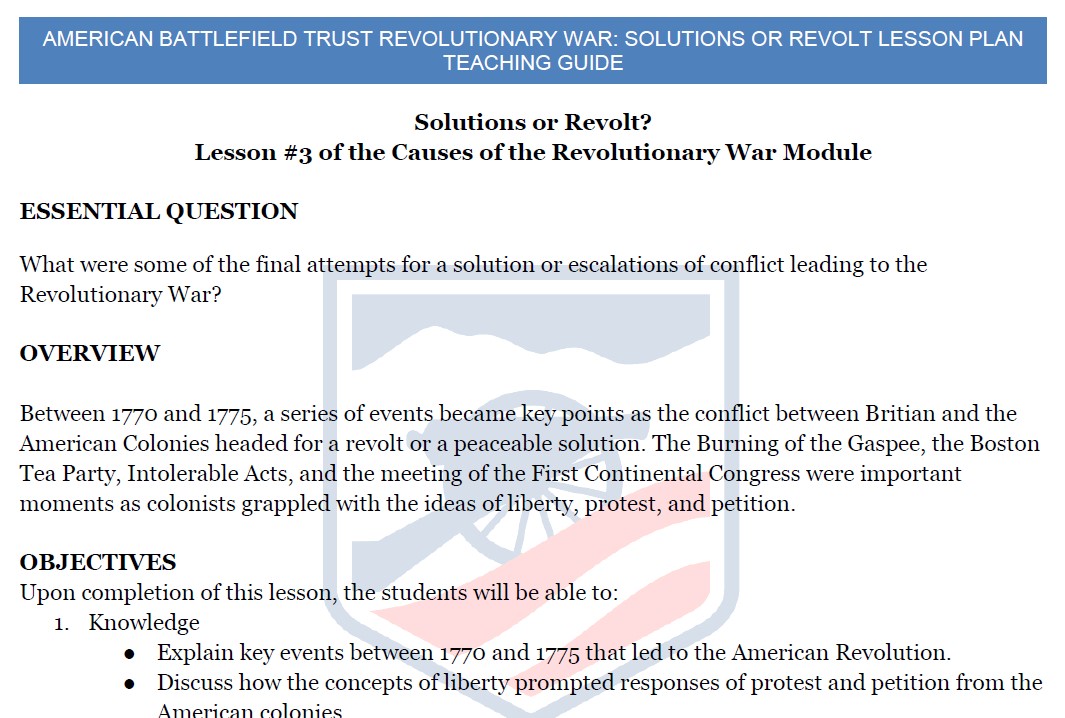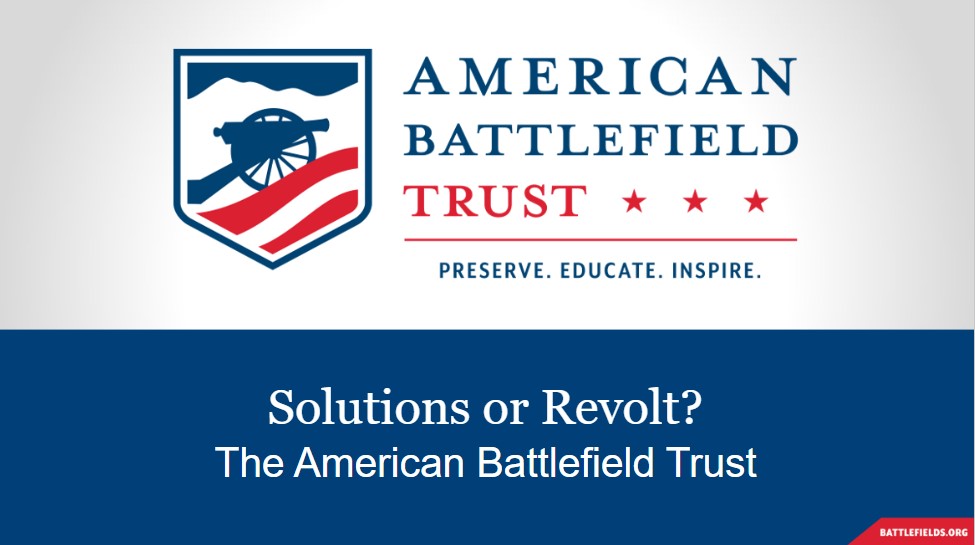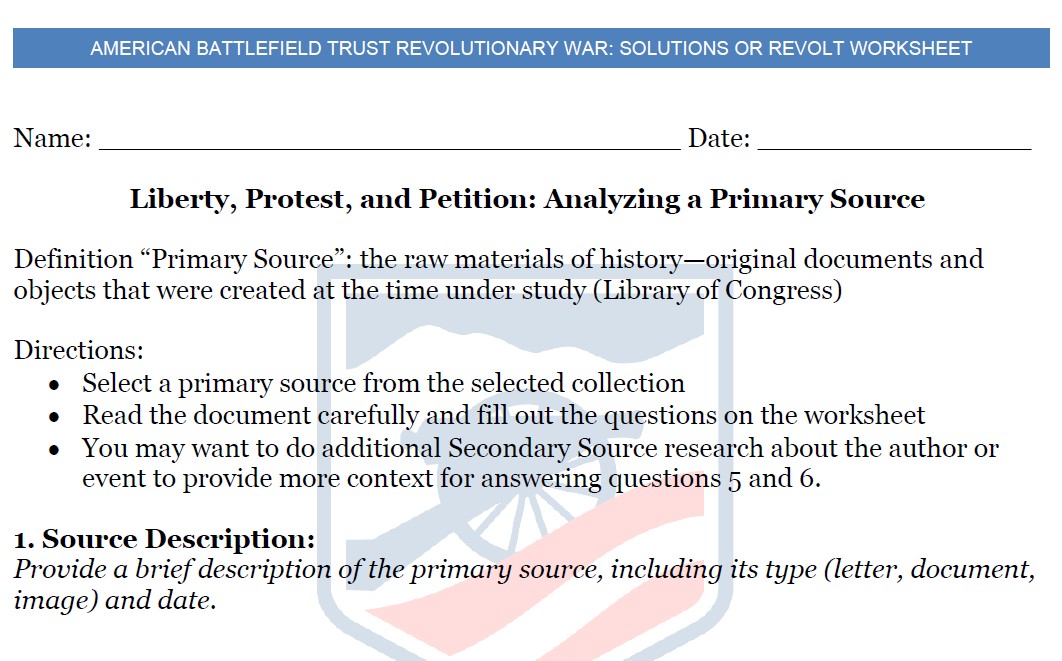
“Boston Tea Party;” by W.W. Cooper. Engraving in The History of North America, 1789.
Solutions or Revolt? Lesson Plan
A lesson plan for use in middle and high school classrooms.
Between 1770 and 1775, a series of events became key points as the conflict between Britian and the American Colonies headed for a revolt or a peaceable solution. The Burning of the Gaspee, the Boston Tea Party, Intolerable Acts, and the meeting of the First Continental Congress were important moments as colonists grappled with the ideas of liberty, protest, and petition.
This Lesson Plan can be used as a prepared resource by following this curriculum plan which aligns to NCSS and Common Core Standards.
This Lesson Plan's assets can also be used on their own as supplemental resources. The display format is prepared for easy access, exploring, and learning.
Causes of the Revolutionary War Module
Upon completion of this lesson, the students will be able to:
1. Knowledge
- Explain key events between 1770 and 1775 that led to the American Revolution.
- Discuss how the concepts of liberty prompted responses of protest and petition from the American colonies.
2. Comprehension/Application/Analysis
- Examine a primary source and analyze the elements of protest, petition, or liberty in the document.
3. Evaluation
- Evaluate how responses to these key events continued the cycle of protest and led to the conflict of the Revolutionary War and eventual American Independence.
Check out the Lesson Plan Teaching Guide for more instructions on using the prepared Lesson Plan.
Lesson Plan Primary Source Activity:
- Use the Lesson’s PowerPoint to explore the context and history; the PowerPoint introduces Essential Questions and lays foundational knowledge about the conflict.
- Watch the video “Boston Tea Party In4”
- Define and discuss definitions and meanings of “Liberty,” “Protest,” and “Petition”
- Distribute the primary source worksheet and have the students choose a document from the provided primary sources for this lesson. Students may work on their own or as a group.
- Students will read the primary source and answer the questions on their worksheet, considering elements of liberty, protest, and petition.
- Students may present their reflections from the worksheet verbally or written
- 6 selected primary sources are available under the “Primary Source” section this lesson plan page.
OPTIONAL HOMEWORK/ASSESSMENT/ADDITIONAL ACTIVITIES:
Option 1: The Boston Tea Party
Students research a historical figure and consider his or her response to the Boston Tea Party. Students can write a journal entry (imagining they are this historical person), write a brief third-person essay report, or perhaps present their findings with costumes or props.
Six selected biographies are available on the Lesson Plan Page and would be suitable for this activity. Secondary and primary sources related to the Boston Tea Party are also listed on the Lesson Plan Page.
Option 2: Writing a Petition
Have your students learn about some of the colonial attempts to petition King George III and the British Parliament.
Students can make a list of concerns (historic or modern) and draft a petition to bring awareness or action.
Common Core State Standards- ELA & History/Social Studies
Grades 6-8
- Key Ideas and Details:
- CCSS.ELA-LITERACY.RH.6-8.2
- Determine the central ideas or information of a primary or secondary source; provide an accurate summary of the source distinct from prior knowledge or opinions.
- CCSS.ELA-LITERACY.RH.6-8.2
- Craft and Structure:
- CCSS.ELA-LITERACY.RH.6-8.4
- Determine the meaning of words and phrases as they are used in a text, including vocabulary specific to domains related to history/social studies.
- CCSS.ELA-LITERACY.RH.6-8.6
- Identify aspects of a text that reveal an author's point of view or purpose (e.g., loaded language, inclusion or avoidance of particular facts).
- CCSS.ELA-LITERACY.RH.6-8.4
- Integration of Knowledge and Ideas:
- CCSS.ELA-LITERACY.RH.6-8.8
- Distinguish among fact, opinion, and reasoned judgment in a text.
- CCSS.ELA-LITERACY.RH.6-8.8
Grades 9-10
- Key Ideas and Details:
- CCSS.ELA-LITERACY.RH.9-10.1
- Cite specific textual evidence to support analysis of primary and secondary sources, attending to such features as the date and origin of the information.
- CCSS.ELA-LITERACY.RH.9-10.2
- Determine the central ideas or information of a primary or secondary source; provide an accurate summary of how key events or ideas develop over the course of the text.
- CCSS.ELA-LITERACY.RH.9-10.1
- Craft and Structure:
- CCSS.ELA-LITERACY.RH.9-10.4
- Determine the meaning of words and phrases as they are used in a text, including vocabulary describing political, social, or economic aspects of history/social science.
- CCSS.ELA-LITERACY.RH.9-10.4
- Integration of Knowledge and Ideas:
- CCSS.ELA-LITERACY.RH.9-10.8
- Assess the extent to which the reasoning and evidence in a text support the author's claims.
- CCSS.ELA-LITERACY.RH.9-10.8
Grades 11-12
- Key Ideas and Details:
- CCSS.ELA-LITERACY.RH.11-12.2
- Determine the central ideas or information of a primary or secondary source; provide an accurate summary that makes clear the relationships among the key details and ideas.
- CCSS.ELA-LITERACY.RH.11-12.3
- Evaluate various explanations for actions or events and determine which explanation best accords with textual evidence, acknowledging where the text leaves matters uncertain.
- CCSS.ELA-LITERACY.RH.11-12.2
- Craft and Structure:
- CCSS.ELA-LITERACY.RH.11-12.4
- Determine the meaning of words and phrases as they are used in a text, including analyzing how an author uses and refines the meaning of a key term over the course of a text (e.g., how Madison defines faction in Federalist No. 10).
- CCSS.ELA-LITERACY.RH.11-12.6
- Evaluate authors' differing points of view on the same historical event or issue by assessing the authors' claims, reasoning, and evidence.
- CCSS.ELA-LITERACY.RH.11-12.4
- Integration of Knowledge and Ideas:
- CCSS.ELA-LITERACY.RH.11-12.8
- Evaluate an author's premises, claims, and evidence by corroborating or challenging them with other information.
- CCSS.ELA-LITERACY.RH.11-12.8
Social Studies - National Council for the Social Studies
- Theme 2: Time, Continuity, and Change
- Theme 3: People, Places, and Environments
- Theme 5: Individuals, Groups, and Institutions
- Theme 6: Power, Authority, and Governance
- Theme 9: Global Connections
- Theme 10: Civic Ideals and Practices
This Lesson plan
contains the following:
3 Activities | 20 Resources
This Lesson plan is a part of:
Revolutionary War Curriculum | Causes of the Revolutionary War Module



